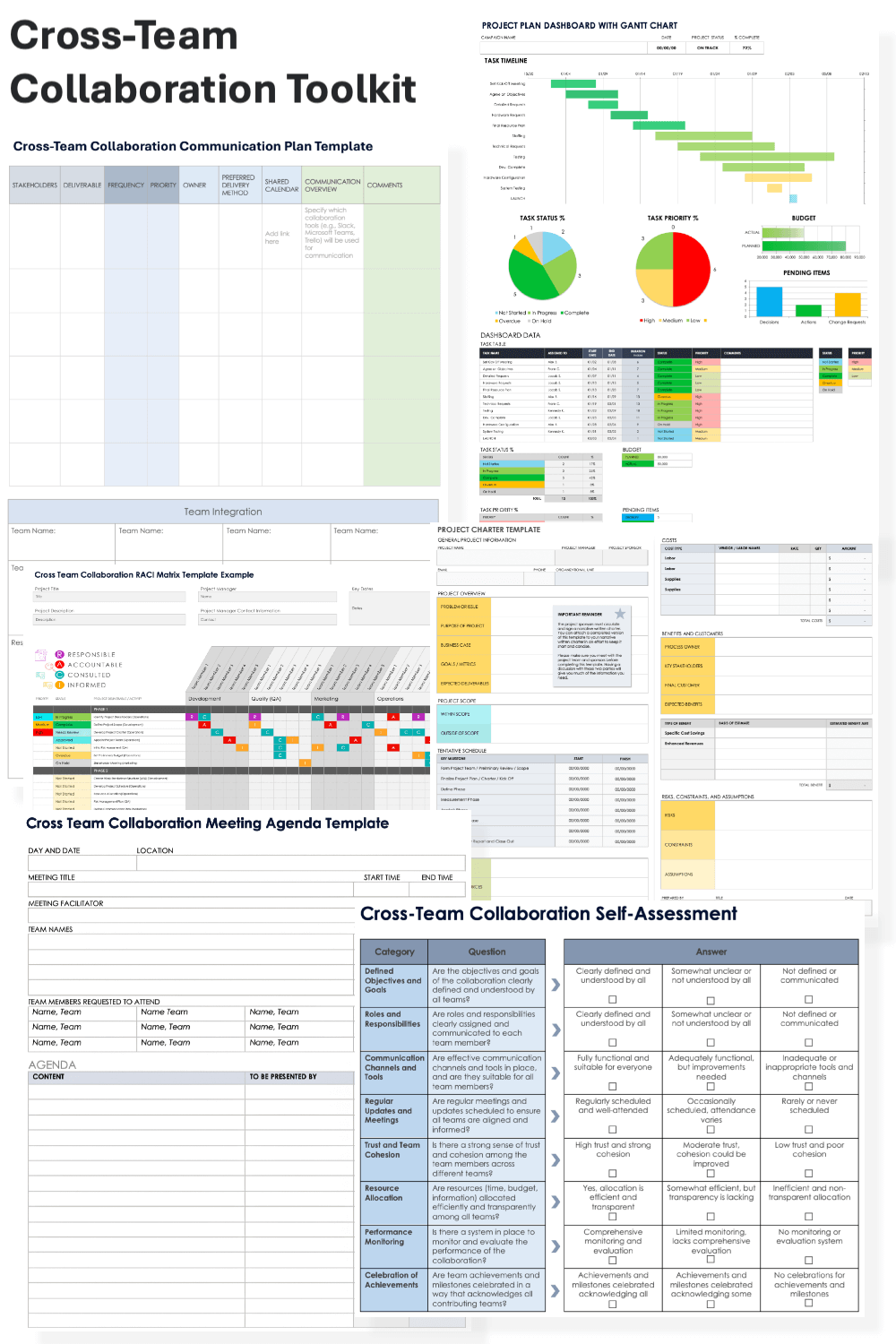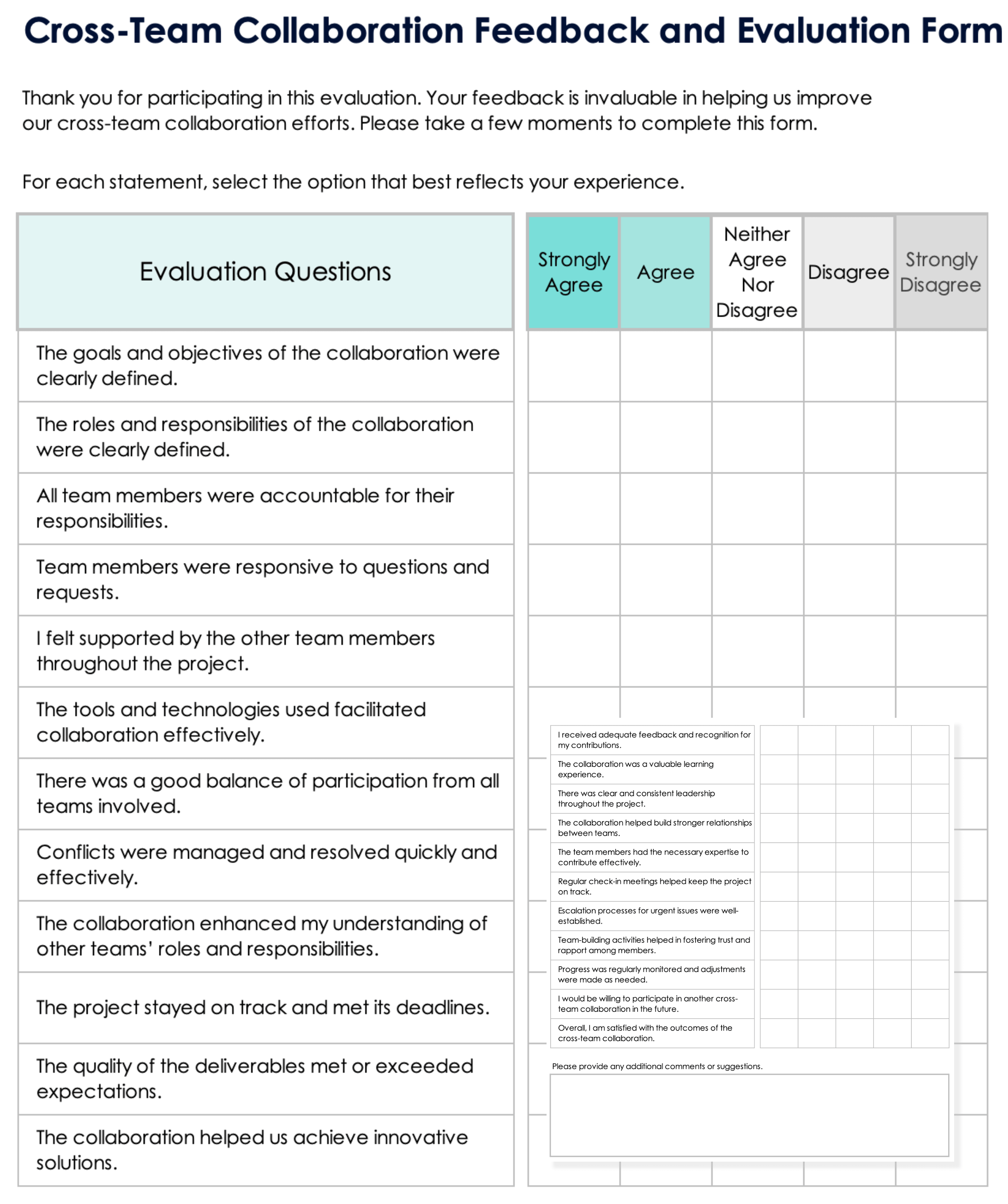How to Build Cross-Team Collaboration
Cross-team collaboration is when multiple teams work together, combining their expertise and resources to achieve a shared goal. Organizations can build cross-team collaboration by establishing clear goals, fostering open communication, assigning defined roles, and using collaborative tools.
Company leaders — such as Laia Quintana, Head of Marketing and Sales at TeamUp — use cross-team collaborations to integrate diverse expertise and achieve complex project objectives in innovative ways. “Since I lead two busy teams, my job is to make sure both teams are on the same page and working together toward our goals,” she says. “This alignment is key to driving our growth and delivering great value to our clients.”

Cross-team collaboration is closely related to cross-functional collaboration. Many experts use the terms interchangeably, but others note a subtle difference: Cross-team collaboration refers to different teams with the same function working together, while cross-functional collaboration involves team members from various departments or functions.
“In a cross-team collaboration, you may have two programming teams working on different segments of a software development project, but the teams have the same function within the organization,” explains Bryan Berthot, Scrum Master, Project Manager, and doctoral candidate at the University of South Florida. “In a cross-functional collaboration, the entities may be on different teams, but the distinction is that they have different functional roles within the organization.”

“For example, on a large development project, programmers may collaborate with database administrators and hardware engineers, with each group discharging different but necessary functions to get the job done,” says Berthot.
Two other related concepts are collaborative teamwork, which refers to collaboration within a single team, and collaboration marketing, which refers to two or more organizations working together to improve their marketing outcomes. Learn more in these guides to collaborative teamwork and collaboration marketing.
7 Steps for Building Cross-Team Collaboration
To build a successful cross-team collaboration, start by defining clear objectives. From there, you can assemble the team, establish communication channels, build team relationships, create a project plan, and monitor progress. Finally, formally acknowledge and celebrate progress and success.
Follow these seven steps to set up your cross-team collaboration for success:
Define Clear Objectives and Goals
Identify the purpose of this cross-team collaboration. Why is it necessary? What are the goals you aim to achieve through this collaboration?
“This is often done in a formal document called the project charter, a predecessor to the project plan,” Berthot explains. “The project charter summarizes (at a high level) the work to be done on the project, announces the project to the organization, and gives the project manager authority to start spending money on the project.”
Learn more about project charters by downloading one of these free project charter templates.Create a Project Plan
In a cross-team collaboration, crafting a comprehensive project plan is crucial to align all teams around common goals and timelines. Use input from all teams to define the project’s scope, objectives, and deliverables.
“A detailed project plan should clearly define roles and responsibilities, set achievable deadlines, and include a strategy for managing risks,” explains Quintana. “This helps everyone know what they need to do and when, making it easier to stay on track and avoid issues. A solid plan keeps everyone accountable and engaged, making the collaboration much smoother.”
For a comprehensive look at everything that goes into creating a project plan, see this guide to writing a winning project plan, with free, downloadable templates and examples.Assemble the Team and Assign Responsibilities
The next step is to select team members and assign roles and responsibilities. What specific skills or areas of expertise do you need to achieve the goals outlined in your project charter? Depending on the project, each team involved in the collaboration might only need to use a few team members.
Once you assemble the team, you can assign roles and responsibilities. Make sure everyone has ownership over specific tasks and key knowledge areas to ensure the whole project runs smoothly. Try one of these free RACI templates to create a responsibility matrix that you can refer to throughout the project.Establish Communication Channels
Clear communication is key to any successful collaboration. Before starting any work, agree on each of the communication channels you will use and when you will use them. For instance, your team might decide to use Slack for daily updates and quick questions, while reserving email for detailed reports, formal communications, and external correspondence.
Decide on a schedule for regular check-in meetings or updates to ensure steady progress and to keep everyone informed. Try one of these meeting templates to help you set agendas and record minutes.
Tip: Sometimes an urgent issue requires attention outside work hours, but team members don’t always agree on what is urgent. Avoid conflict by establishing guidelines early on for when and how to escalate urgent issues.Foster Team Building
Building trust and rapport is essential, especially if your cross-team collaboration involves bringing together team members who’ve never worked as a unit before. Organize team-building activities that encourage interaction and familiarity. For example, you might arrange online game sessions or virtual coffee breaks to keep remote teams engaged, while in-person teams could benefit from workshops or group lunches.
“One strategy that has worked well for me is organizing regular workshops where different teams can sync up their processes,” says Quintana. “These workshops help align our workflows, share best practices, and resolve any issues. They also give team members a chance to get to know each other and understand each other's roles better. By having these structured sessions, we make sure everyone is on the same page and working efficiently toward our goals.”
For some team-building exercise ideas, see this interactive guide to selecting team activities.Monitor Progress and Adjust
Set up a system of regular progress reviews, using dashboards or progress tracking tools that are accessible to all teams. During these reviews, discuss any deviations from the plan, identify bottlenecks, and gather feedback from team members on challenges they are facing. Use this information to make informed adjustments to the project plan, such as timelines or resource allocation.
“During project work estimates, have representatives from each team or functional group present,” recommends Berthot. “This ensures that all project tasks and task interdependencies are identified. It also makes for more accurate time and cost estimates. At the beginning of the project, setting this standard establishes shared expectations for the remainder of the project.”Celebrate Achievements
Organize events or acknowledgments that highlight the efforts and successes of all teams involved in the collaboration. These celebrations can be as formal as award ceremonies or as casual as team shout-outs during meetings. At a larger organization, make sure to communicate successes widely, perhaps through newsletters or company announcements. Celebrating wins not only boosts team spirit but also reinforces the collaborative culture, encouraging continued cooperation for this and future projects.
“For me, it’s all about setting the right example and fostering a team spirit,” says Quintana. “I make sure to join in team activities and always recognize and reward teamwork. This shows everyone that collaboration is valued.”
Cross-Team Collaboration Toolkit

Download the Cross-Team Collaboration Toolkit
This cross-team collaboration toolkit is packed with every tool you need to start managing complex projects involving multiple teams. By providing resources such as a project plan dashboard template, a RACI matrix, and a communication plan, this toolkit helps leaders stay organized, track progress, and effectively mitigate risks that might arise on cross-team projects.
In this kit, you’ll find:
A project charter template for Excel to clearly define goals and objectives from the outset.
A project plan dashboard template with a Gantt chart for Excel to track each team’s deliverables and the cost of work against the project budget.
A cross-team collaboration RACI matrix for Excel to clarify roles and responsibilities for both teams and individual team members.
A cross-team collaboration communication plan template for Microsoft Word to specify collaboration tools and establish regular intra-team communication.
A cross-team meeting agenda template for Microsoft Word to keep regular sync-up meetings organized, concise, and productive.
A cross-team collaboration self-assessment for Microsoft Word to quickly assess the readiness and ongoing health of your cross-team collaboration efforts.
Strategies to Improve Cross-Team Collaboration
Improving cross-team collaboration involves several strategies and best practices that foster communication, trust, and alignment among different teams. Here are some effective approaches:
Centralize Communication: Using one platform for all team communications can greatly improve collaboration.
“One of the most impactful strategies I’ve employed in cross-team collaboration is the creation of a centralized communication hub,” says Sidharth Ramsinghaney, Director of Strategy and Operations at Twilio. This centralized communication hub, he says, “was particularly effective during Twilio’s first-ever divestiture: the IoT divestiture to KORE Wireless.”
“The program was complex, involving two organizations, 10-plus teams, and 100-plus stakeholders across different functions and regions. The goal was to ensure a smooth transition of the IoT business, which required meticulous planning and execution and clear communication,” he says.
“I established a Divestiture Management Office (DMO), which acted as the central node for all project-related communication. This office was responsible for disseminating strategy and vision, resolving cross-functional and cross-company blockers, coordinating efforts, and tracking progress across teams. I utilized a combination of tools such as Slack for real-time communication, project management software for tracking milestones and deliverables, all-hands calls for program-level communication, problem-solving calls and async Google docs for topic-level resolution of blockers, and end-of-week status updates to the steering committee,” Ramsinghaney notes.
This approach ensured that all teams were aligned and responsive. “The result was a well-executed transition that met all our strategic, operational, and financial targets,” says Ramsinghaney.Define Clear Objectives: Ensure that every team understands the overall project goals, as well as their specific responsibilities and how their work contributes to the larger objectives.
“We leverage the objectives and key results (OKRs) framework to drive our company objectives. OKRs act as a driving force for cross-functional collaboration,” says Ramsinghaney. “These OKRs cascade down the organization, compelling and inspiring teams to work together to achieve overarching business outcomes, rather than just individual tasks.”
Learn more about leveraging OKRs for your next cross-team collaboration with this essential guide to OKRs.Assign Task Ownership: Identifying a primary owner for each task helps clarify responsibilities and accountability. “While several people may work on a task, one person is ultimately responsible for the deliverable,” Berthot explains. “This gives the owner a vested interest in its completion because she’s the one who gets called out in meetings.”
Select a Single Leader: Similarly, identifying a single project leader ensures consistent guidance and effective communication across teams. “Have one leadership voice speak to the teams,” suggests Berthot. “Whether there’s an overall project manager or a project manager for each team, the collaborating teams crave leadership from one source. This leader needs to be specified during the project kickoff meeting.”
In cases where it’s not possible to have a single leader, ensuring consistency among managers becomes essential. “If there are multiple project managers across teams, each one needs to project the same message,” says Berthot.Use Collaboration Tools: Adopt tools that facilitate easy communication and project management. “At Twilio, we leverage various tools such as Slack direct messages and group chats, in addition to live calls, to build cross-functional collaboration,” says Ramsinghaney.
Learn about some free collaboration tools in this article on real-time document collaboration. These tools help keep everyone on the same page and streamline workflows.Foster a Culture of Open Communication: Encourage an environment where feedback and open communication are valued. Make it easy for team members to voice concerns and suggestions without fear of negative repercussions.
“We also hold program-level problem-solving sessions and foster connectivity through initiatives such as all-hands meetings and learning sessions, which are crucial for nurturing a collaborative environment,” explains Ramsinghaney.Keep Teams Synchronized: Open communication is crucial, but to be effective, it must be supported by consistent, reliable status updates. “Regular communications keep the teams synchronized,” explains Berthot. “I prefer employing multiple methods, as not everyone absorbs information in the same modality. Make use of meetings, the project blog, canned reports, and instant messaging apps to provide critical updates to your key personnel.”
This is especially true during major updates or unexpected changes. “When dependencies change, everyone needs to know about it,” says Berthot. “I’ve never worked on a project where everything went as planned. Particularly when you have interdependencies between teams, changes need to be communicated to all stakeholders immediately.”Leadership Involvement and Support: Ensure that leaders from each team are involved and supportive of cross-team initiatives. Leadership can set the tone for collaboration by being proactive and visibly engaged with their teams.
“Identifying a project champion in management is crucial to fostering cross-team cooperation,” Berthot says. “The project champion has a vested interest in project success, and sometimes only a champion in senior management has the legitimate authority to break logjams that arise between teams with differing priorities and outlooks.”
Cross-Team Collaboration Feedback and Evaluation Form

Download a Cross-Team Feedback and Evaluation Form for
Excel | Microsoft Word | Adobe PDF
One strategy to ensure strong cross-team collaborations is to request feedback from team members. Project managers can use this free form to evaluate the effectiveness of their cross-team collaborations and identify areas for improvement. Distribute this form to the team members involved in a collaborative project, either at the end of the project or after reaching a key milestone, and collect their responses. Review the feedback to find patterns, and then develop plans to address identified issues and maintain strengths for future projects.
Benefits of Cross-Team Collaboration
Cross-team collaboration offers unique benefits by combining diverse skills and perspectives, which leads to innovative problem-solving. This approach not only helps teams meet complex goals but also fosters broader understanding and alignment across an organization.
Here are some benefits to look forward to in your next cross-team collaboration:
Improved Creativity and Problem-Solving: By leveraging the unique strengths and viewpoints of various teams, cross-team collaboration enhances the ability to tackle complex problems effectively. “These collaborations often lead to a rich exchange of ideas and knowledge sharing, which can drive creative solutions and better decision-making,” says Ramsinghaney.
Stronger Sense of Community: Engaging multiple teams in shared projects helps build interdepartmental bonds and a unified organizational culture. Cross-team collaborations “can foster a stronger sense of community within the organization, as teams work toward a common goal,” shares Ramsinghaney.
Higher Employee Engagement and Satisfaction: Working with colleagues from different teams can make work more engaging and satisfying because it breaks monotony and enhances the understanding of other teams’ roles and responsibilities.
Accelerated Learning and Knowledge Sharing: Collaboration between teams allows for the transfer of knowledge and skills, helping employees learn from each other and accelerating learning across the organization. “In my experience, particularly with the IoT divestiture at Twilio, these collaborations have been instrumental in breaking down silos and leveraging the collective strengths of the organization to achieve strategic objectives,” Ramsinghaney explains.
More Accurate Work Estimates: One benefit of cross-team collaborations, says Berthot, “is more accurate estimates of project work, costs, and time. This results from having multiple subject-matter experts evaluate the tasks that need to be done to complete a product feature. Thus, you start the project with a better baseline schedule, one that requires less change requests in the middle of the project.”
Accelerated Customer Value Delivery: Strengthening collaboration strategies can enhance customer value delivery. “Such collaboration fosters the delivery of faster customer value,” says Berthot. “When interdependencies are coordinated, handoffs between teams are faster. The result is that both the features visible to the customer and the underlying infrastructure (i.e., technical debt) are completed faster, with minimal delays.”
Berthot shares the following real-world example from his time at a telecom firm, illustrating one potential way cross-team collaboration can benefit a team doing an equipment upgrade:
“At a telecom firm, when doing equipment upgrades (i.e., changing cabling, routers, and servers) at a digital streaming TV site in the field, you often have hardware engineers, software developers, and project managers as part of the effort,” says Berthot. “These upgrades are done at night to minimize customer service disruptions. Prior to the upgrade, the project manager collaborates with the technical leads to develop a standard operating procedure (SOP) document which guides the effort. During the upgrade, you have a designated lead, directing each step for the team. In this way, the interdisciplinary team makes fewer mistakes, the work goes faster, and upgrades are aborted less frequently.”
Learn how collaboration can change your workplace for the better with this guide to workplace collaboration.
Challenges of Cross-Team Collaboration
While essential for achieving complex objectives, cross-team collaboration comes with its own set of challenges that can disrupt projects. These challenges stem from differences in team cultures, misaligned goals, and communication barriers, and they require strategic forethought to address.
In their study, “Cross-functional collaboration in the early phases of capital projects: Barriers and contributing factors,” researchers at the Construction Industry Institute (CII) and the University of Texas identified and ranked barriers to cross-functional collaboration in capital projects. These researchers concluded that it is crucial to establish clear business objectives early on to prevent confusion and delays, and ensure alignment between different functions or teams to avoid miscommunication and conflicting goals. Additionally, setting realistic targets and expectations is essential to maintain effective collaboration and avoid wasting resources or overrunning the project budget or schedule. “Cross-functional collaboration neither comes automatically nor automatically leads to improved performance,” they write.
Here are some of the most common challenges of cross-team collaboration and how to address them:
Lack of Support from Upper Management: One of the most-cited barriers to cross-functional collaboration in the CII study was inadequate support from higher-ups. When senior leadership does not actively support cross-team collaborations, it is difficult to secure the resources and authority needed to drive initiatives forward.
“Gaining upper management support was crucial,” explains Ramsinghaney. “I achieved this by engaging senior leaders in the planning stages, providing them with regular progress updates, and involving them in critical problem-solving sessions that had long-term impact on the growth and trajectory of the business. Their buy-in was instrumental in driving the project forward and in securing their support.”High Personnel Turnover: Team stability is crucial for maintaining the momentum of collaborative projects. High turnover rates can lead to delays and reduced effectiveness in collaboration.
“Intrateam and interteam collaborations are negatively impacted when team membership changes,” warns Berthot. “Particularly on visible projects, strive to minimize the inevitable schedule and technical disruptions caused by personnel turnover.”Delayed Team Onboarding: In addition to keeping turnover as low as possible, ensuring timely integration of team members is critical for seamless cross-team collaboration.
“An easy way to sabotage cross-team collaboration is to wait too long to hire team members or to bring in new employees mid-project,” Berthot explains. “Late-arriving personnel may be unable to contribute to the effort or their vestigial presence will distract seasoned team members from getting work done. This slows down the project.”
To address this challenge, establish a proactive recruitment and integration process that ensures new team members are hired and oriented efficiently.Poorly Defined Roles: Ambiguity in roles and responsibilities can cause overlap in tasks, inefficiencies, and conflicts.
“A common pitfall in cross-team collaboration is the lack of defined roles, leading to confusion,” says Ramsinghaney. “It’s crucial to establish clear responsibilities from the start to ensure efficient teamwork.”Lack of Team Autonomy: Without sufficient autonomy, teams may struggle with slow decision-making and reduced motivation. Teams and individuals perform better when they have some authority over their work and feel they can make impactful decisions.
“I addressed this by clearly defining roles and responsibilities from the outset,” says Ramsinghaney. “Each team knew their scope of work and had the autonomy to make decisions within that scope. This clarity empowered teams and prevented overlaps and conflicts.”Unclear Business Objectives: If business objectives are not clearly communicated from the beginning, teams may lack a unified direction, resulting in misaligned efforts and inefficient use of resources.
“To ensure business objectives were clear, I developed a comprehensive project charter that outlined the vision, goals, and key success metrics for the divestiture,” Ramsinghaney explains. “This document served as a guiding star for all teams involved.”Unrealistic Expectations and Targets: Setting goals that do not align with the actual capabilities of the teams can lead to increased stress and diminished morale.
“Setting realistic targets was achieved through collaborative goal-setting or an integration planning process,” Ramsinghaney says. “I engaged with all teams to understand their capabilities and limitations, which helped in setting achievable milestones and expectations.”
Challenges of Remote Cross-Team Collaboration
Managing cross-team collaboration remotely requires leaders to address a unique set of challenges. Here are three common challenges to — and practical solutions for — ensuring smooth and secure remote collaboration:
Differences in Time Zones: When collaborating teams are working in different time zones, it can disrupt synchronization. This can lead to delayed responses and difficulty scheduling real-time interactions, which are crucial for timely project advancement.
Solution: Schedule meetings for overlapping work hours using shared calendars, and get in the habit of recording important meetings for those unable to attend live.
“At Twilio, a remote-first company, I’ve led cross-team collaborations with teams that were entirely remote,” says Ramsinghaney. “We proactively identified time slots favorable for cross-time zone collaboration and scheduled meetings well in advance. This allowed all team members to plan and prioritize their participation. The key to success was effective and timely communication, coupled with clear expectations of each member’s role in these meetings.”Low Team Cohesion: The physical separation of remote work can lead to feelings of isolation and disconnection, lowering the cohesion and engagement necessary for successful cross-team collaborations.
Solution: Counteract isolation by hosting regular virtual meetings that include coffee hours or informal chats. If resources permit, organize an annual retreat to strengthen bonds. Incorporate structured icebreakers into regular check-ins, which should also include some time for social interaction to build a stronger team connection.
Quintana notes, “Time zone differences and missing out on those spontaneous office chats can be tough. To tackle this, I set clear schedules that consider everyone's time zones, and also use tools like Miro for virtual brainstorming sessions, to help build those relationships.”
“We organized virtual team-building activities and regular check-ins to foster a sense of community,” adds Ramsinghaney. “We also ensured that each team member had a voice in meetings and decisions, regardless of their location.”Security and Data Privacy: The reliance of remote teams on digital communication and data sharing across multiple networks increases the risk of breaches and unauthorized access.
Solution: Different teams will have different security and privacy standards. Ensure everyone is on the same page by enforcing stringent security protocols and offering comprehensive training on data privacy. Use secure, encrypted tools for communication, and ensure that software is regularly updated. For highly sensitive data, consider providing dedicated company devices such as laptops.
When in doubt, stick to the standards set by the larger organization. “My approach was to adhere strictly to Twilio’s established security and data policies, ensuring all collaboration occurred within our approved tech stack,” says Ramsinghaney.
To find more tips and strategies, see these guides to collaboration, communication, and team-building for remote teams.
Tools to Help with Cross-Team Collaboration
Effective cross-team collaboration often relies on specialized tools. Team communication platforms that offer real-time messaging and videoconferencing ensure that communication remains fluid and accessible. Additionally, investing in project management software allows organizations to more easily track tasks, deadlines, and progress, keeping all team members aligned and informed throughout the project lifecycle.
Achieve Effective Cross-Team Collaboration with Smartsheet for Work Management
Empower your people to go above and beyond with a flexible platform designed to match the needs of your team — and adapt as those needs change.
The Smartsheet platform makes it easy to plan, capture, manage, and report on work from anywhere, helping your team be more effective and get more done. Report on key metrics and get real-time visibility into work as it happens with roll-up reports, dashboards, and automated workflows built to keep your team connected and informed.
When teams have clarity into the work getting done, there’s no telling how much more they can accomplish in the same amount of time. Try Smartsheet for free, today.
